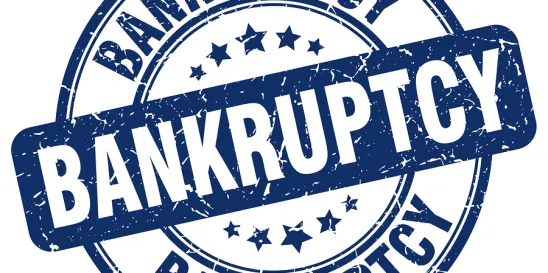While global inflation and higher-for-longer interest rates dominated macroeconomic headlines over the last year, middle-market private credit restructurings witnessed three notable trends.
First, these credits remained surprisingly resilient, evidenced by a default rate that, though higher than prior periods, remained below 2% for most of the year. Second, those companies experiencing distress largely suffered balance sheet problems that could be addressed on a consensual basis, without the winner-take-all (or at least winner-take-most) battles that have become all too familiar. And third, lenders spent an increased amount of time considering—with some degree of justified concern—whether the status quo of minimally coercive maneuvers would change, or whether one or more of their credits would prove an exception to that general rule.
By comparison, in 2023, the dominant trend in the broadly syndicated loan and high-yield markets was the continued use of liability management strategies and market participants’ rapt attention to the growing list of lower court decisions evaluating which moves are out of bounds and which are fair play in permissive debt documentation.
In distressed credits, though the documents, parties, capital structures and other circumstances varied, the highest-level objective of equity owners was nearly unanimous: live to fight another day. As inflation cooled and consensus shifted towards an economic soft-landing and anticipated rate decreases, the perceived value of extending runway increased, incentivizing sponsors to work with their lenders on a negotiated path forward.
Back in the middle market, the necessary modifications—including amend and extends, covenant relief, debt service deferrals and capital infusions—were mostly implemented without resorting to aggressive structures. In these negotiations, parties both leaned on existing relationships and gamed out alternative paths, including various liability management transaction (LMT) scenarios, such as drop-downs (e.g., J. Crew), uptiers (e.g., Serta) and double-dips (e.g., Trinseo).
Simply put, direct lenders hoped for the best, but prepared for the worst. Nothing else could be the case in a market built on relationships, but where terms—though still generally lender favorable compared to the broadly syndicated loan and high-yield markets—have been in a decade-long trend toward borrower- and sponsor-favorable flexibilities.
Uptier Battles: Long-Awaited Closure . . . Maybe
Troubled borrowers facing tight debt markets have limited options for tapping additional liquidity. Often, only incumbent lenders are willing to infuse new capital to protect existing investments, but even then, only with enhanced economics. The “uptier”—an exchange (or “roll-up”) of existing loans into new, higher-priority, priming debt—has become the most talked-about LMT, and synonymous with the attention-getting phrase “lender-on-lender violence.” Uptiering generally has two steps: (1) the borrower and certain participating lenders (i.e., Required Lenders) amend the existing credit documents to allow for the creation of, and subordination of the claims or liens of the existing senior lenders to, one or more tranches of “super-priority” debt, and (2) the participating lenders exchange, on a non-pro rata basis (and without a pro rata offer being made to all lenders), their existing loans for the new super-senior debt (typically ranking junior to any new money debt and senior to the existing loans of non-participating lenders).
Serta, Boardriders, TriMark and Mitel Networks exemplify the legal battles that follow in the wake of uptier transactions and offer guidance on how courts will resolve related legal disputes.
Serta
Of those cases, Serta must be the brand-name. By now, not only are private credit lenders familiar with the Serta non-pro rata uptier transaction, but they commonly inquire about the inclusion (or not) of a “Serta provision” in credit documents to determine whether an uptier transaction would be clearly prohibited (or not).
To effectuate step (2) described above—where the participating lenders exit their position in the existing facility and exchange into a higher-priority tranche—the consenting lenders in Serta (and other similar cases) relied on the credit agreement provision giving the borrower the right to make “open market purchases” of loans.[1] As is typical, the Serta credit agreement generally prohibited non-pro rata repayments of loans, but allowed these non-pro rata purchases. But, the phrase “open market purchase” was not defined in the Serta credit agreement—or, for that matter, in the vast majority of credit agreements in the market. The non-participating lenders (plaintiffs) and the participating lenders (defendants) vigorously and litigiously disagreed as to its meaning.
Serta maintained that “open market” means—and the provision merely requires—an arm’s length exchange of consideration that constitutes fair market value. Judge Failla of the Southern District of New York rejected this argument at the motion to dismiss stage because she could not find the transaction, as alleged, unambiguously took place in what is conventionally understood as an “open market” and permitted the case to move forward.
But, after Serta filed for bankruptcy, the dispute was heard by the Bankruptcy Court for the Southern District of Texas, and Judge Jones took a markedly different stance. Judge Jones made it clear that he did not have any trouble determining that what took place in Serta was an open market purchase, which, per the dictionary definition of “open market,” required only that the price was set based on competition among private parties. Seemingly critical to this ruling was the fact that Serta solicited competing LMT offers and, while no specific transaction was offered to all lenders, interested parties did have an opportunity to offer a solution.
Stay tuned, as the decision has been accepted for direct appeal to the Fifth Circuit Court of Appeals.
Mitel Networks
Mitel Networks is another example of a disputed uptier exchange transaction that survived a motion to dismiss. In October 2022, Mitel Networks secured a $156 million new-money super-priority facility and simultaneously exchanged and uptiered the existing term loans held by participating lenders. Like Serta and Boardriders, only a select group of lenders were invited to participate. As a result of the transaction, first and second lien debt held by non-participating creditors was relegated to second and third lien priority behind approximately $857 million of new first priority loans.
Excluded lenders filed suit in the New York Supreme Court, arguing that the uptiering violated their “sacred rights”—i.e., matters over which every adversely affected lender has a consent right under the loan documents. The plaintiffs argued that their sacred rights included a prohibition on non-pro rata distributions and any reduction of term loan principal that adversely impacts the value of the non-participating lenders’ loans, including a reduction in the principal amount of the participating lenders’ loans by virtue of the exchange. The participating lenders defended the transaction by reference to the undefined “purchase” exception to pro rata treatment under the credit agreement, which allowed Mitel to purchase and then cancel loans on a selective basis. In denying dismissal, Justice Jennifer Schecter was not convinced that the non-participating lenders’ breach of contract claims were invalid as a matter of law and decided that she could not adequately define “purchase” in this context, allowing the matter to move forward toward trial.
Bombardier
“Required Lenders” is defined in most credit agreements to generally consist of those lenders holding a majority of the relevant loans. When that threshold is reached, Required Lenders are empowered to take a number of actions (other than those protected against by “sacred rights”), including waiving most events of default.
Enter Bombardier Inc., a Canadian company that for much of its history operated as a diversified transportation conglomerate with four core businesses: business aircraft, commercial aircraft, aerostructures and engineering services and rail transportation. In 2017, the company decided to reposition itself away from its diversified business model and initiated a series of divestitures that, when the dust settled in 2021, left Bombardier with only its business aircraft segment.
Although these divestitures implemented the company’s strategic vision, the transactions ran afoul of a contractual prohibition against the sale or disposition of all or substantially all of the company’s assets (taken as a whole, whether by a single or series of related or unrelated transactions and regardless of whether those transactions occurred over an (unspecified) period of time). In an effort to address the issue, Bombardier subsequently issued $260 million in new notes (an increase of 104%) to a single institutional investor, ostensibly giving that investor Required Lender control. The investor then retroactively waived the event of default triggered by the restructuring transactions. In response, the certain aggrieved noteholders sued.
As a threshold matter, Justice Andrew Borrok of the New York Supreme Court determined that the new notes did not count for purposes of waiving past defaults and, therefore, the waiver granted by the new noteholder was ineffective. Specifically, the indenture provided that only noteholders holding notes at the time of the relevant default are entitled to waive the corresponding event of default, a temporal limitation not present in most credit agreements. Absent that limitation, the new investor could have waived the event of default on account of its (subsequent) Required Lender control. However, the temporal element precluded a retroactive waiver and the applicable event of default continued unresolved.
However, the indenture also contained a “no-action” clause granting only the indenture trustee, as directed by Required Holders, the power to pursue most claims. Unlike the waiver provisions, the no-action clause did not include the same temporal protections—i.e., Required Lenders was not calculated by reference to the date of the underlying event of default. Accordingly, Justice Borrok dismissed the noteholders’ complaint without prejudice, granting the plaintiffs another opportunity to demonstrate why compliance with the no-action clause would be futile or inapplicable.
The Proxy Play: Alive and Well
Exercising a proxy right is a powerful remedy that is available to many private credit lenders. When a secured lender is granted a proxy (often memorialized in the underlying security agreement), the lender (usually through the collateral agent) is entitled, following an event of default, to vote shares or membership interests that are pledged as collateral for a loan. In practice, proxy rights are typically used to replace a borrower’s board of directors (or similar governing body) with new independent directors.
CII
In an important decision for private credit lenders, the Delaware Bankruptcy Court held that a proxy properly exercised prepetition will not be invalidated by a subsequent bankruptcy filing.
By way of background, CII filed a chapter 11 petition in December 2022. Just days before, the senior collateral agent provided notice that it was exercising its voting proxy and replacing the board of one of CII’s non-debtor subsidiaries. On a post-petition basis, CII demanded that the agent unwind its proxy exercise to allow CII to regain control of its subsidiary. The agent refused, and CII sought relief from the bankruptcy court, arguing the agent’s refusal to return control of the subsidiary to CII was a violation of the Bankruptcy Code’s automatic stay. CII asserted that the subsidiary’s equity was property of its bankruptcy estate and, therefore, the agent’s effective control over the subsidiary was both an improper attempt to control estate property and a post-petition debt collection effort.
Bankruptcy Judge Laurie Selber Silverstein rejected CII’s arguments, relying on Delaware law and the text of the underlying credit agreement. Although there is no dispute that equity interests in a corporate subsidiary constitute property of the shareholder’s bankruptcy estate, Judge Silverstein’s analysis turned on whether the voting rights associated with those equity interests were also estate property. Judge Silverstein determined that, under Delaware law, the economic rights represented by corporate shares may be separated or “decoupled” from the power to vote the shares. To establish an automatic stay violation, CII would need to show that the agent did not exercise its proxy rights in accordance with Delaware law and the precise terms of the credit agreement were such that CII retained its right to vote shares of its subsidiaries at the time of the bankruptcy filing.
After parsing the terms, Judge Silverstein found that the credit agreement unequivocally authorized the agent to exercise CII’s voting rights, the agent provided the requisite notice, and Delaware’s default three-year limit on voting proxies was replaced with a longer term under the credit agreement. Having properly exercised its proxy rights prior to the chapter 11 filing, Judge Silverstein concluded that CII’s estate did not include the right to vote subsidiary shares at the time its petition was filed because CII had been divested of that right prepetition. Accordingly, there was no automatic stay violation and the agent’s independent directors were allowed to remain in place.
Byju’s Alpha
In Byju’s Alpha, Vice Chancellor Morgan T. Zurn of the Delaware Chancery Court likewise validated a proxy exercise based on a textual interpretation of the governing credit agreement. After a series of defaults, the administrative agent accelerated the loan and exercised its proxy rights, simultaneously replacing the company’s board of directors with a single independent director. Shortly thereafter, the agent filed a complaint in the Delaware Chancery Court seeking a declaratory judgment that the new director’s control over the company was legitimate. In response, Byju’s Alpha filed a complaint in the New York Supreme Court challenging the acceleration of the debt. The agent answered by stating the company had indeed defaulted by failing to deliver audited financials and, separately, to obtain a guaranty from a foreign subsidiary as required by the credit agreement—as such, the acceleration underpinning the agent’s proxy exercise was proper.
However, before the matter was decided in New York, Vice Chancellor Zurn ruled from the bench that the company had, in fact, defaulted on its loan and events of default ultimately resulted. Those events of default opened the door for the agent to accelerate the debt and replace the board of directors, notwithstanding Byju’s Alpha’s attempt to characterize the defaults as “non-monetary” and “de minimis” in nature.
Although the Delaware Chancery Court’s ruling has been appealed, both CII and Byju’s Alpha illustrate the important concept that, when it comes to a lender’s exercise of remedies, the precise terms of the loan documents control and will be enforced by courts.
New Delaware Law Gives Boost to Secured Creditors
The Delaware General Corporation Law (“DGCL”) has long required majority stockholder approval of a transaction seeking to sell, lease or exchange all or substantially all of the corporation’s property and assets. The problem for private credit lenders: the sponsor’s consent was likely necessary to sell substantial assets of a corporation after exercising proxy rights. However, in July 2023, the Delaware state legislature added an important exception from a secured creditor’s perspective: under new DGCL section 272(b), stockholder approval is not required if the secured party can sell the collateral without the corporation’s consent under applicable law, including state law governing the mortgage or other security interest (e.g., Article 9 of the UCC). Alternatively, the secured party and the board of directors may agree to an alternative transaction, such as a strict foreclosure or sale to a third party, without obtaining stockholder approval, if the value of the assets is less than or equal to the amount of secured debt forgiven in the transaction.
While amended section 272 does not prescribe a particular method of asset valuation, once the transaction is complete, the statute forecloses any attempt to invalidate or rescind the transaction based on a purported failure to satisfy the asset value test if the buyer of the assets provided value (which may be the reduction/elimination of debt secured by the assets) and acted in good faith. To reenforce the foregoing, section 272(b) overrides provisions in certificates of incorporation (that first become effective on or after August 1, 2023) generally requiring stockholder consent to effectuate a sale, lease or exchange of substantially all assets, unless the certificate of incorporation expressly provides for stockholder approval of section 272(b) compliant transactions.
See our Special Alert for additional discussion on this topic.
Millennium Health: Just What Are “Securities”?
The U.S. Court of Appeals for the Second Circuit issued a widely anticipated (unanimous) decision holding that notes evidencing syndicated leveraged loans do not qualify as “securities” covered by state and federal securities laws.
The issue arose out of the bankruptcy cases of Millennium Health (f/k/a Millennium Laboratories), a California-based urine drug testing company. The Millennium lender claim trustee (formed as part of the bankruptcy) filed a complaint in the New York Supreme Court against several large banking institutions, asserting claims for, among other things, securities fraud under various state “blue sky” laws in connection with a nearly $1.8 billion syndicated leveraged loan previously made to Millennium Laboratories. The trustee asserted that during and after syndication, the defendant lenders misrepresented or omitted material facts in the offering materials. To secure the securities fraud hook, the trustee argued that the modern generation of syndicated bank loans no longer resemble typical commercial lending practices and instead closely resemble regulated high yield bond issuances.
In May 2020, Judge Paul Gardephe of the Southern District of New York dismissed the trust’s claims, concluding the market of highly sophisticated purchasers of the notes would not reasonably consider the notes “securities” subject to federal and state securities law regulation.
On appeal, the Second Circuit considered application of the so-called Reves test, a Supreme Court precedent directing that courts consider four factors when determining whether a note legally qualifies as a security: (1) motivations that would prompt a reasonable seller and buyer to enter into the transaction, (2) the plan of distribution, (3) the reasonable expectations of the investing public and (4) whether some factor such as the existence of another regulatory scheme significantly reduces the risk of the instrument. While the Second Circuit agreed that the seller and buyer motivations arguably satisfied the conditions of the test, despite the sale being “commercial” in nature as opposed to an “investment,” the Second Circuit determined that the remaining Reves factors tilted against any plausible suggestion that syndicated loans qualify as securities.
Following the ruling, the trustee petitioned for the U.S. Supreme Court to decide the matter once and for all. If the Supreme Court accepts the case, it will be notable to see if the Securities and Exchange Commission, which declined the Second Circuit’s request for guidance, decides to reverse course and weigh in.
Revlon Revisited
Last year, we covered Revlon’s liability management troubles. See Liability Management – Vaccine or Pandemic? Private Credit Restructuring Year in Review. As readers may recall, in 2016, Revlon entered into a $1.7 billion senior secured term loan agreement (the “2016 Facility”) in connection with the acquisition of Elizabeth Arden. In 2019, Revlon procured a $200 million term loan (the “2019 Facility”) to address liquidity needs, and, in connection with that transaction, transferred certain valuable intellectual property collateral out of reach of the 2016 Facility creditors to a foreign (unrestricted) subsidiary (“BrandCo”). In 2020, faced with the prospect of insolvency and in further need of liquidity, Revlon transferred the vast majority of the remaining intellectual property serving as collateral for the 2016 Facility, including that related to the Elizabeth Arden brand, to BrandCo and entered into a third term loan agreement with a subset of lenders under the 2016 Facility (the “2020 Facility”), providing for new super-priority first lien debt and roll up a portion of the 2016 Facility into two new roll-up facilities. The new-money debt was used in part to repay the 2019 Facility and was secured on a first lien basis by the intellectual property transferred to BrandCo.
Fast-forward to Revlon’s bankruptcy cases, where non-participating lenders revived their attack on the 2019 and 2020 transactions, and the overall validity of the 2020 Facility. The aggrieved lenders sought to unwind the transaction and restore what they described as their “rightful first-lien priority position” on the transferred intellectual property, or, alternatively, provide them the economic equivalent of invaliding the transaction, whether through damages or equitable subordination.
Since we last wrote on the topic, Judge Jones of the Southern District of New York issued an opinion granting the debtors’ motion to dismiss the non-participant lender’s complaint, finding the state law centric equitable relief claims against the debtors are derivative and are an impermissible attempt to strategically “use inventive pleading to sidestep the automatic stay,” which bars individual creditors from pursuing individual collection actions that would usurp or interfere with potential recoveries or remedies exclusively available to the debtors’ bankruptcy estates or a trustee. Judge Jones further found that the plaintiffs’ allegations that their alleged injuries are “uniquely felt” because their liens were “improperly” stripped by the BrandCo transfers do not make their claims non-derivative, even if their injuries are “large and painful.” While not dispositive of the claims against the non-debtor defendants (i.e., the participant lenders), Judge Jones hinted at a later status conference that the same standing analysis applied equally to any non-debtor defendants, effectively “knocking out” any further claims.
A Look Ahead: Setting Winners Apart from Losers
The uncertain landscape that private credit lenders face in 2024 sets the stage for another action-packed year. Distressed portfolio companies will continue to navigate volatility in the months ahead, and lenders must always stay situationally aware of all the moves available on the game board from the perspective of the sponsor, majority lenders, minority lenders and other junior investors. Contingency planning and a deep understanding of credit documentation will set the winners apart from the losers.
[1] Visit our prior Year in Review for additional details.
Adam B. Nowicki and Joseph W. Bretschneider also contributed to this article.Matthew R. Koch, Adam B. Nowicki, and Joseph W. Bretschneider also contributed to this articleer.








 />i
/>i

